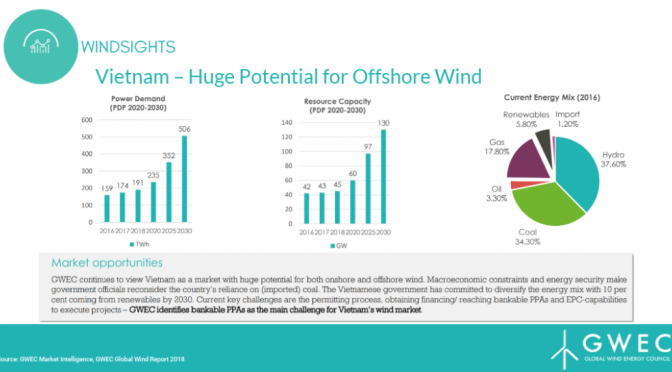Offshore wind power is primed to become an optimal source of power reserve for Vietnam’s energy system. Its various advantages such as a high scalability, predictability flexibility, and of course its low environmental impact mean that this renewable energy technology can be used to stabilise and decarbonise Vietnam’s electricity system.
Capturing the Potential of Offshore Wind Energy in Vietnam
The first offshore wind farm in the Mekong Delta region, the 99 MW Bac Lieu wind power project, first came online in 2013. Since then, there has been a growing industry appetite to develop offshore wind power in Vietnam, with the technical potential for fixed and floating offshore wind turbines in the country estimated at 309 GW of capacity.
However, key challenges in government policy need to be urgently resolved in order to support large-scale deployment of offshore wind energy:
Key challenges and recommendations
Ensure policy stability in the long-term energy plan. Government targets for the offshore sector should be included in the national Power Development Plan VIII (currently pending) for 2025, 2030 and 2050, in order to establish investor confidence in the offshore sector in Vietnam. Among various policy signals, the offshore Feed-in Tariff (FiT) in Vietnam should be extended to at least 2025, providing the industry with sufficient time to establish project pipelines while investing and engaging in manufacturing and service supply chains in Vietnam.
Improve the bankability of the current PPA. The bankability of offshore wind power should be improved by lowering the risk factors around the termination, arbitration and curtailment clauses of the current PPA, in order to attract greater international investment.
Shape industrial policy to build capacity for an offshore wind turbines supply chain. Actors in government, industry and development organisations should step up activities and funding for capacity and capability for building the offshore wind energy sector. This includes developing supportive industrial policy and investment roadmaps which account for the complexity and specialised requirements of the offshore wind turbines value chain.While these will be the three principal factors that could boost Vietnam’s offshore sector, there are further lessons from Europe and emerging Asian markets like Taiwan which can be translated into policy recommendations for Vietnam. From enhancing and aligning coordination between different federal (especially the Ministry of Industry and Trade, Ministry of Natural Resources and Environment and Ministry of Planning and Investment) and municipal/local decision-making bodies, to establishing clear rules on the site identification and leasing process, to developing a grid installation roadmap in parallel with the development of offshore wind projects – it is crucial that government support is there to support this burgeoning market.
Recognising and clearing these obstacles now will clear the path for a bright future of the offshore wind industry in Vietnam. If the country can reach its offshore potential, it will be able to bring in local and foreign investment, create local and sustainable jobs and supply chains, lower its carbon emissions and assume a leading role in the energy transition in South East Asia.
Established in June 2019, GWEC’s South East Asia Task Force is the official industry platform driving wind energy growth and the energy transition in the region. With one of the highest potentials globally for wind energy, South East Asia is the next big market for the industry with a growing population and economy needing more clean and reliable power. Gathering all the relevant stakeholders in the region, from local to international industry leaders and investors, this Task Force provides the much needed platform for the wind industry to engage with policymakers, generate market intelligence and build capacity in key markets such as Vietnam, Thailand, the Philippines and Indonesia to ensure that the necessary frameworks and government support are in place for the region reaches its wind energy potential.


